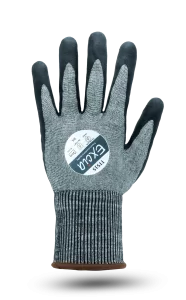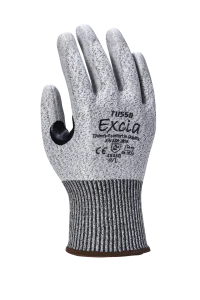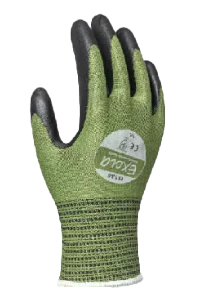Cut-Resistant Gloves for Aviation and Transportation Industry
Why Workers Need Cut-Resistant Gloves in Aviation and Transportation Industry
The daily tasks in the vehicle maintenance and repair industry demand labour skills and the adequate capacity of tools to ensure a smooth operation process.
Physical Injuries
➤ Acute damage can happen during aircraft maintenance, which involves bending, reaching, stretching, pulling, and lifting.
Fatigue Risks
➤ Errors and accidents attributed to fatigue aviation maintenance personnel.
Harmful Substances
➤ Maintenance workers are exposed to hazardous substances and chemicals like petrol, solvents, degreasers, paints, and other cleaning liquids.


Why Choose Our Cut-Resistant Gloves As Your Solutions
Unbeatable Durability
➤ Our highly durable glove materials can withstand high abrasion work in aviation and transportation.
Maximize Peace Of Mind
➤ Our protective wear is tested against oil and chemical liquids to ensure workers have peace of mind.
Stress-Free
➤ Our lightweight, breathable protective clothing ensures outstanding comfort even in prolonged wearing, alleviates exhaustion, and prevents aviation maintenance accidents.
Standards & Quality
➤ Our protective wear complies with CE standards.
Recommended Cut-Resistant Gloves for Aviation and Transportation Industry
Frequently Asked Questions Regarding Cut-Resistant Gloves
What are cut-resistant gloves?
Cut-resistant gloves are a crucial form of personal protective equipment (PPE) to safeguard the wearer’s hands from lacerations, punctures, and cuts. They are essential across various industries where workers interact with sharp implements, including food processing, metal fabrication, and construction. Constructed from high-performance materials like Kevlar and HPPE (High-Performance Polyethylene), these gloves offer varying degrees of protection and skill to achieve an optimal balance between safety and functionality.
Which type of gloves protect against cuts?
When it comes to cut and puncture protection, several materials reign supreme: high-performance polyethylene (HPPE), known for its incredible strength and flexibility; Kevlar, famous for its heat resistance but also boasting excellent cut defense; and stainless steel mesh, the go-to for heavy-duty cut hazards, though sometimes bulky. Leather offers some cut protection but pales compared to these specialized materials.
Who should wear cut-resistant gloves?
Cut-resistant gloves are essential for many professions where workers interact with sharp objects. Here’s a breakdown of some key industries and tasks where cut-resistant gloves are crucial:
Food Processing:
Butchers and meat processors handling knives and cleavers
Workers in food preparation dealing with graters, mandolines, and other sharp utensils
Metalworking:
Sheet metal workers handling sharp edges
Metal fabricators using saws, shears, and punches
Glass Handling:
Glaziers installing and cutting glass
Workers in glass manufacturing and transportation
Construction:
Drywall installers handling utility knives
Roofers working with sheet metal and roofing materials
Forestry and Landscaping:
Chainsaw operators requiring protection from accidental cuts
Workers using hedge trimmers, pruning shears, and other sharp tools
What is the importance of cut-resistant gloves?
Cut-resistant gloves are crucial for personal protective equipment (PPE) in many professions and situations. Their primary function is to shield your hands from cuts and lacerations caused by sharp objects. Here’s a breakdown of why they are essential:
Reduced Injury Severity: While not entirely cut-proof, these gloves are designed to significantly lessen the severity of cuts you might sustain. This can differ between a minor nick and a deep laceration requiring stitches.
Protection from Various Sharp Objects: Cut-resistant gloves are handy when working with a variety of sharp items, including blades, glass, and metal, in the construction, automotive, aviation, and transportation industries.
Enhanced Safety and Reduced Costs: Cut-resistant gloves contribute to a safer work environment by preventing cuts and injuries. This translates to fewer medical expenses, lost work days, and potential lawsuits for employers.
What are the different levels of cut-resistant gloves based on EN 388:2016 (Europe)?
The EN 388:2016 (Europe) standard uses two methods to assess cut resistance in gloves:
1. TDM-100 Test (Preferred Method):
This test measures the force (in Newtons) required to cut through the glove material with a sharp blade. Like ANSI cut level, it utilizes a letter grading system (A to F) to indicate cut resistance, with:
- A: Lowest cut resistance (2 Newtons)
- B: (5 Newtons)
- C: (10 Newtons)
- D: (15 Newtons)
- E: (25 Newtons)
- F: Highest cut resistance (over 30 Newtons)
2. Old Coup Test (Optional):
Though not mandatory, this older method is still included in the standard. It uses a numeric scale (1 to 5) for cut resistance:
- 1: Lowest cut resistance
- 2, 3, 4: Increasing levels of cut resistance
- 5: Highest cut resistance
Protect Your Hands with Our Cut Resistant Gloves!
Don’t compromise your safety at work or home. Excia‘s cut-resistant gloves provide unmatched protection and durability, keeping your hands safe from sharp objects and accidents. They are suitable for DIY projects, kitchen work, and professional use. Order now and experience the ultimate in hand protection with our gloves, which are more cut, puncture, and tear-resistant!





